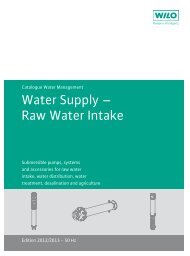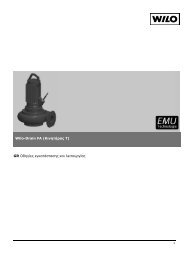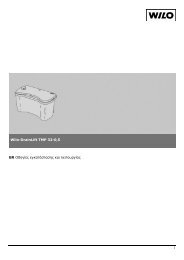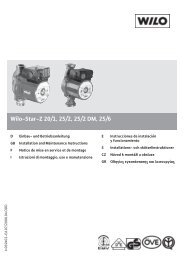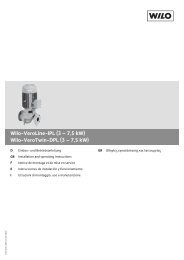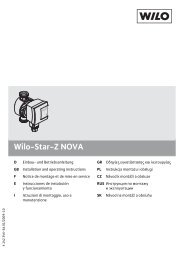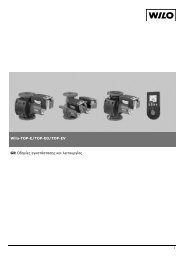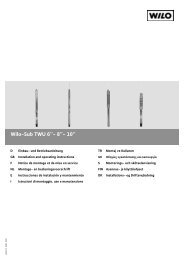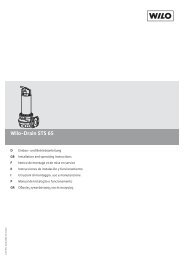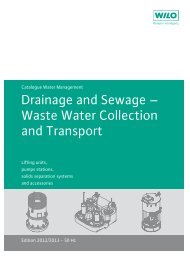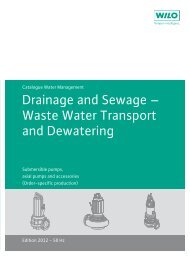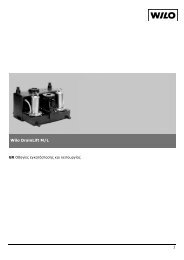Wilo-Drain TS 40/10, TS 40/14 TS 40/10 A, TS 40/14 A
Wilo-Drain TS 40/10, TS 40/14 TS 40/10 A, TS 40/14 A
Wilo-Drain TS 40/10, TS 40/14 TS 40/10 A, TS 40/14 A
You also want an ePaper? Increase the reach of your titles
YUMPU automatically turns print PDFs into web optimized ePapers that Google loves.
English<br />
• Mains fuse: 16 A, time-lag,<br />
• Pump / installation must be earthed in compliance<br />
with regulations,<br />
• Use a residual current operating device ≤ 30 mA,<br />
• Use a disconnecting device to disconnect from<br />
the mains with a contact gap width of min. 3 mm,<br />
• The pump is ready for connection.<br />
Pump with three-phase current motor<br />
(3 ~ <strong>40</strong>0V):<br />
• For the three-phase current connection (DM) the<br />
leads of the free cable end are to be assigned as<br />
follows:<br />
4-leaded connection cable: 4 x 1,0 2<br />
Lead no brown black blue green/yellow<br />
terminal U V W PE<br />
The free cable end is to be wired up in the switch<br />
box (see switch box Installation and Operating<br />
Instructions).<br />
8 Starting-up<br />
DANGER! Risk of electric shock!<br />
The pump may not be used for draining swimming-pools<br />
/ garden ponds or similar places<br />
when there are people in the water.<br />
CAUTION! Risk of damage to the pump<br />
Prior to starting up the pump, the shaft and the<br />
intake pipes should be freed from solid matter<br />
such as rubbish.<br />
• When filling the shaft or lowering the pump into<br />
the pit make sure that the float switches can move<br />
freely.<br />
• Switch on pump.<br />
9 Maintenance<br />
Maintenance and repair work should only be<br />
carried out by qualified personnel!<br />
WARNING! Risk of infection!<br />
In order to avoid any risk of infection, maintenance<br />
work should only be carried out using<br />
appropriate protective clothing (protective<br />
gloves).<br />
WARNING! Risk of electric shock!<br />
Potential dangers caused by electrical energy<br />
must be excluded<br />
• The pump must be switched off for all maintenance<br />
and repair work and secured against<br />
unauthorised operation.<br />
• In principle, damage to the connecting cable<br />
should only be repaired by a qualified electrician.<br />
• Change oil in the mechanical seal chamber one<br />
times the year.<br />
• Unscrew Oil drain plug with seal (Fig. 1, pos. 21).<br />
• Cant the pump until the oil gets out (use a suitable<br />
collecting basin and dispose the oil correctly).<br />
• Fill in new oil (see connection and electrical data).<br />
• Screw in Oil drain plug with seal.<br />
8.1 Direction of rotation (only for three-phase<br />
current motors)<br />
The correct direction of rotation must be tested<br />
before the pump is submerged. he correct direction<br />
of rotation is indicated by a directional arrow<br />
on the top of the motor housing.<br />
• Hold the pump in your hand,<br />
• Briefly switch on the pump. The pump will move in<br />
the opposite direction to the motor.<br />
• If the direction of rotation is incorrect, 2 phases of<br />
the mains connection must be exchanged.<br />
8.2 Adjusting the control level<br />
CAUTION! Risk of damage to the pump!<br />
The mechanical seal must not run dry!<br />
• Dry running reduces the life of motor and<br />
mechanical seal.<br />
• As protection against dry running for the<br />
mechanical seal, the motor is fitted with an oilfilled<br />
separating chamber.<br />
• The water level may not be reduced below the<br />
minimum immersion depth of the pump. The level<br />
control is originally set at the following level: see<br />
figure 2<br />
• Fig. 2a:<br />
operating mode S3: connection and electrical<br />
data<br />
• Fig. 2b:<br />
operating mode S1: connection and electrical<br />
data<br />
Installation and operating instructions <strong>Wilo</strong>-<strong>Drain</strong> <strong>TS</strong> <strong>40</strong> 11




